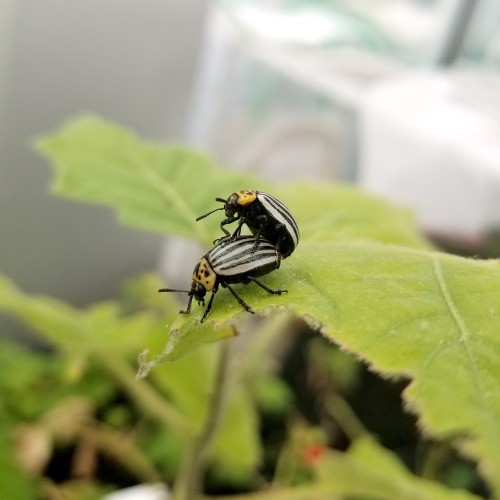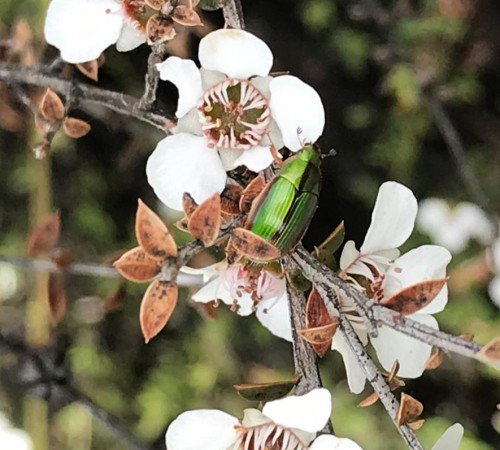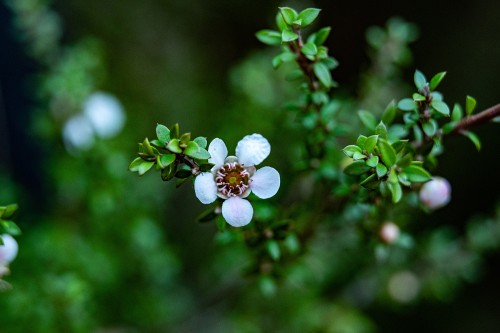Chemical Communication Between Native and Introduced Plants and Insects
How is this relevant to weed biocontrol?

Pico beetle Leptinotarsa undecimlineata
When introduced species colonise a new ecosystem they engage in new chemical interactions with the native species, potentially modifying existing interactions between these native species. Dr Andrea Clavijo-McCormick (Massey University) and her team are exploring chemical communication between native and introduced plant and insect species in the Central Plateau of New Zealand. The volcanic plateau, which is a dual UNESCO world heritage site due to its cultural and natural value, is heavily invaded by heather (Calluna vulgaris). The heather beetle (Lochmaea suturalis) was introduced in 1996 as a biocontrol agent after rigorous host testing to ensure that it will not attack non-host plants. Before the introduction of heather and the heather beetle the area was dominated by native plants and insects, including mānuka (Leptospermum scoparium) and the mānuka beetle (Pyronota festiva). There are anecdotal suggestions that the mānuka beetle might feed on heather, but this has not been tested scientifically. Dr Clavijo-McCormick’s research used a chemical-ecology approach to explore plant–plant and plant–insect interactions between heather, mānuka, the heather beetle, and the mānuka beetle.
Plant–plant interactions

Mānuka beetle
Initial observations from the field suggested that mānuka plants growing in heather-invaded areas produce significantly less scent than when they are paired with other mānuka plants or with other native plant species. In other words, ‘they go quiet’. The mechanisms behind this phenomenon remain to be elucidated, but it could be attributed to changes in soil properties brought about by heather, or changes in resource allocation by the native plant to prepare for competition; for example, by investing more energy in root growth than in producing scents, reducing apparency to herbivores to minimise attack, or a combination of these factors. A controlled experiment using potted plants that were not in contact with soil revealed similar results, suggesting that airborne signals are sufficient to carry information about the identity of nearby plants and elicit a physiological response in the receiving plant.
Plant–insect interactions

Mānuka
A series of laboratory assays was conducted to test the olfactory and feeding preferences of the two beetle species. Beetles were offered their host plant and non-host plant volatiles versus clean air, and their combination in a Y-tube olfactometer. As a follow up, beetles were offered fresh plant material from each plant alone and in combination in a Petri dish. The native mānuka beetle performed poorly in discriminating between its host (manuka) and non-host (heather) plants based on olfactory cues only. However, in the Petri dish tests where other cues (i.e. visual, gustatory, tactile) were present, it showed a preference for mānuka over heather, but fed on heather when it was the only available option. In contrast, the introduced heather beetle showed high host-specificity towards its host in both Y-tube and Petri dish tests.
This work suggests that invasive weeds have the potential to affect chemical communication between native plants and insects by modulating the native plant’s chemical emissions. The effects of these changes on native pollinators, herbivores, and their predators require further study. Dr Clavijo-McCormick’s study also suggests that some native insects may not be able to efficiently discriminate host vs non-host plants, with more generalist species probably using the invasive plant as an alternative host. Feeding on a non-suitable host can have consequences for insect fitness (growth, reproduction, and survival) and could lead to diminished populations or even local extinction over time. On the flip side, nearly 30 years after its initial release the heather beetle remains highly host specific, posing no risk to native plants.
Further reading
Effah E, Barrett DP, Peterson PG, Potter MA, Holopainen JK, Clavijo-McCormick A 2020. Seasonal and environmental variation in volatile emissions of the New Zealand native plant Leptospermum scoparium in weed-invaded and non-invaded sites. Scientific Reports 10: 11736. DOI: 10.1038/s41598-020-68386-4
Effah E, Svendsen L, Barrett DP, Clavijo-McCormick A 2022. Exploring plant volatile-mediated interactions between native and introduced plants and insects. Scientific Reports 12: 15450. DOI: 10.1038/s41598-022-18479-z
This project is funded by the Marsden Fund of the Royal Society of New Zealand
Contact
Andrea Clavijo-McCormick – A.C.McCormick@massey.ac.nz
